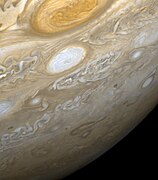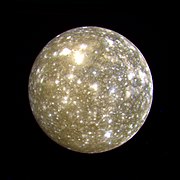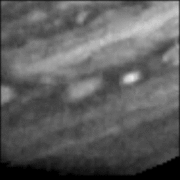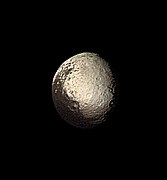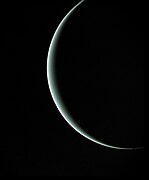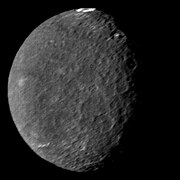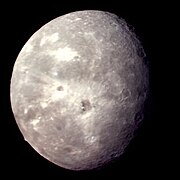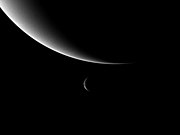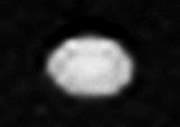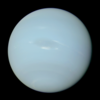Voyager 2
 Model of the Voyager spacecraft design | |
| Mission type | Planetary exploration |
|---|---|
| Operator | NASA / JPL[1] |
| COSPAR ID | 1977-076A[2] |
| SATCAT no. | 10271[3] |
| Website | voyager |
| Mission duration |
|
| Spacecraft properties | |
| Manufacturer | Jet Propulsion Laboratory |
| Launch mass | 721.9 kilograms (1,592 lb)[4] |
| Power | 470 watts (at launch) |
| Start of mission | |
| Launch date | August 20, 1977, 14:29:00 UTC |
| Rocket | Titan IIIE |
| Launch site | Cape Canaveral LC-41 |
| Flyby of Jupiter | |
| Closest approach | July 9, 1979 |
| Distance | 570,000 kilometers (350,000 mi) |
| Flyby of Saturn | |
| Closest approach | August 26, 1981 |
| Distance | 101,000 km (63,000 mi) |
| Flyby of Uranus | |
| Closest approach | January 24, 1986 |
| Distance | 81,500 km (50,600 mi) |
| Flyby of Neptune | |
| Closest approach | August 25, 1989 |
| Distance | 4,951 km (3,076 mi) |
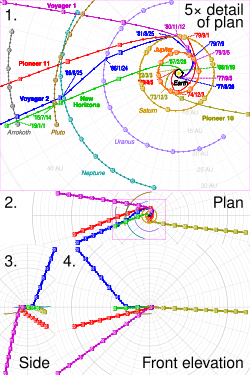
Plot 1 is viewed from the north ecliptic pole, to scale.
Plots 2 to 4 are third-angle projections at 20% scale.
In the SVG file, hover over a trajectory or orbit to highlight it and its associated launches and flybys.
Voyager 2 is a space probe launched by NASA on August 20, 1977, to study the outer planets and interstellar space beyond the Sun's heliosphere. As a part of the Voyager program, it was launched 16 days before its twin, Voyager 1, on a trajectory that took longer to reach gas giants Jupiter and Saturn but enabled further encounters with ice giants Uranus and Neptune.[5] Voyager 2 remains the only spacecraft to have visited either of the ice giant planets. Voyager 2 was the third of five spacecraft to achieve Solar escape velocity, which allowed it to leave the Solar System.
Voyager 2 successfully fulfilled its primary mission of visiting the Jovian system in 1979, the Saturnian system in 1981, Uranian system in 1986, and the Neptunian system in 1989. The spacecraft is now in its extended mission of studying interstellar space. It has been operating for 47 years, 2 months and 23 days as of November 13, 2024 UTC [refresh]; as of July 9, 2023[update], it has reached a distance of 133.041 AU (19.903 billion km; 12.367 billion mi) from Earth.[6]
The probe entered interstellar space on November 5, 2018, at a distance of 119.7 AU (11.1 billion mi; 17.9 billion km) (about 16:58 light-hours)[7] from the Sun[8] and moving at a velocity of 15.341 km/s (34,320 mph)[9] relative to the Sun. Voyager 2 has left the Sun's heliosphere and is traveling through the interstellar medium, a region of outer space beyond the influence of the Solar System, joining Voyager 1, which had reached the interstellar medium in 2012.[10][11][12][13] Voyager 2 has begun to provide the first direct measurements of the density and temperature of the interstellar plasma.[14]
Voyager 2 remains in contact with Earth through the NASA Deep Space Network.[15] In 2020, maintenance to the Deep Space Network cut outbound contact with the probe for eight months. Contact was reestablished on November 2, 2020, when a series of instructions was transmitted, subsequently executed, and relayed back with a successful communication message.[16] On February 12, 2021, full communications with the probe were restored after a major antenna upgrade that took a year to complete. The DSS 43 communication antenna, which is solely responsible for communications with the probe, is located near Canberra, Australia.[17]
History
Background
In the early space age, it was realized that a periodic alignment of the outer planets would occur in the late 1970s and enable a single probe to visit Jupiter, Saturn, Uranus, and Neptune by taking advantage of the then-new technique of gravity assists. NASA began work on a Grand Tour, which evolved into a massive project involving two groups of two probes each, with one group visiting Jupiter, Saturn, and Pluto and the other Jupiter, Uranus, and Neptune. The spacecraft would be designed with redundant systems to ensure survival through the entire tour. By 1972 the mission was scaled back and replaced with two Mariner program-derived spacecraft, the Mariner Jupiter-Saturn probes. To keep apparent lifetime program costs low, the mission would include only flybys of Jupiter and Saturn, but keep the Grand Tour option open.[5]: 263 As the program progressed, the name was changed to Voyager.[18]
The primary mission of Voyager 1 was to explore Jupiter, Saturn, and Saturn's moon, Titan. Voyager 2 was also to explore Jupiter and Saturn, but on a trajectory that would have the option of continuing on to Uranus and Neptune, or being redirected to Titan as a backup for Voyager 1. Upon successful completion of Voyager 1's objectives, Voyager 2 would get a mission extension to send the probe on towards Uranus and Neptune.[5]
Spacecraft design
Constructed by the Jet Propulsion Laboratory (JPL), Voyager 2 included 16 hydrazine thrusters, three-axis stabilization, gyroscopes and celestial referencing instruments (Sun sensor/Canopus Star Tracker) to maintain pointing of the high-gain antenna toward Earth. Collectively these instruments are part of the Attitude and Articulation Control Subsystem (AACS) along with redundant units of most instruments and 8 backup thrusters. The spacecraft also included 11 scientific instruments to study celestial objects as it traveled through space.[19]
Communications
Built with the intent for eventual interstellar travel, Voyager 2 included a large, 3.7 m (12 ft) parabolic, high-gain antenna (see diagram) to transceive data via the Deep Space Network on the Earth. Communications are conducted over the S-band (about 13 cm wavelength) and X-band (about 3.6 cm wavelength) providing data rates as high as 115.2 kilobits per second at the distance of Jupiter, and then ever-decreasing as distance increases, because of the inverse-square law. When the spacecraft is unable to communicate with Earth, the Digital Tape Recorder (DTR) can record about 64 megabytes of data for transmission at another time.[20]
Power
Voyager 2 is equipped with three Multihundred-Watt radioisotope thermoelectric generators (MHW RTG). Each RTG includes 24 pressed plutonium oxide spheres, and provided enough heat to generate approximately 157 W of electrical power at launch. Collectively, the RTGs supplied the spacecraft with 470 watts at launch (halving every 87.7 years). They were predicted to allow operations to continue until at least 2020, and continued to provide power to five scientific instruments through the early part of 2023. In April 2023 JPL began using a reservoir of backup power intended for an onboard safety mechanism. As a result, all five instruments are expected to continue operation through 2026.[19][21][22][23]
-
RTG inner heat source
-
RTG assembly
-
RTG unit
Attitude control and propulsion
Because of the energy required to achieve a Jupiter trajectory boost with an 825-kilogram (1,819 lb) payload, the spacecraft included a propulsion module made of a 1,123-kilogram (2,476 lb) solid-rocket motor and eight hydrazine monopropellant rocket engines, four providing pitch and yaw attitude control, and four for roll control. The propulsion module was jettisoned shortly after the successful Jupiter burn.
Sixteen hydrazine MR-103 thrusters on the mission module provide attitude control.[24] Four are used to execute trajectory correction maneuvers; the others in two redundant six-thruster branches, to stabilize the spacecraft on its three axes. Only one branch of attitude control thrusters is needed at any time.[25]
Thrusters are supplied by a single 70-centimetre (28 in) diameter spherical titanium tank. It contained 100 kilograms (220 lb) of hydrazine at launch, providing enough fuel until 2034.[26]
Scientific instruments
| Instrument name | Abr. | Description | ||||||||||||||||||||||||||||||||||||||||||||||||||||||||||||||||||||||||||||||||||||||||||||
|---|---|---|---|---|---|---|---|---|---|---|---|---|---|---|---|---|---|---|---|---|---|---|---|---|---|---|---|---|---|---|---|---|---|---|---|---|---|---|---|---|---|---|---|---|---|---|---|---|---|---|---|---|---|---|---|---|---|---|---|---|---|---|---|---|---|---|---|---|---|---|---|---|---|---|---|---|---|---|---|---|---|---|---|---|---|---|---|---|---|---|---|---|---|---|
| Imaging Science System (disabled) |
(ISS) | Utilized a two-camera system (narrow-angle/wide-angle) to provide imagery of the outer planets and other objects along the trajectory. More
| ||||||||||||||||||||||||||||||||||||||||||||||||||||||||||||||||||||||||||||||||||||||||||||
| Radio Science System (disabled) |
(RSS) | Utilized the telecommunications system of the Voyager spacecraft to determine the physical properties of planets and satellites (ionospheres, atmospheres, masses, gravity fields, densities) and the amount and size distribution of material in Saturn's rings and the ring dimensions. More
| ||||||||||||||||||||||||||||||||||||||||||||||||||||||||||||||||||||||||||||||||||||||||||||
| Infrared Interferometer Spectrometer (disabled) |
(IRIS) | Investigates both global and local energy balance and atmospheric composition. Vertical temperature profiles are also obtained from the planets and satellites as well as the composition, thermal properties, and size of particles in Saturn's rings. More
| ||||||||||||||||||||||||||||||||||||||||||||||||||||||||||||||||||||||||||||||||||||||||||||
| Ultraviolet Spectrometer (disabled) |
(UVS) | Designed to measure atmospheric properties, and to measure radiation. More
| ||||||||||||||||||||||||||||||||||||||||||||||||||||||||||||||||||||||||||||||||||||||||||||
| Triaxial Fluxgate Magnetometer (active) |
(MAG) | Designed to investigate the magnetic fields of Jupiter and Saturn, the solar-wind interaction with the magnetospheres of these planets, and the interplanetary magnetic field out to the solar wind boundary with the interstellar magnetic field and beyond, if crossed. More
| ||||||||||||||||||||||||||||||||||||||||||||||||||||||||||||||||||||||||||||||||||||||||||||
| Plasma Spectrometer (active) |
(PLS) | Investigates the macroscopic properties of the plasma ions and measures electrons in the energy range from 5 eV to 1 keV. More
| ||||||||||||||||||||||||||||||||||||||||||||||||||||||||||||||||||||||||||||||||||||||||||||
| Low Energy Charged Particle Instrument (active) |
(LECP) | Measures the differential in energy fluxes and angular distributions of ions, electrons and the differential in energy ion composition. More
| ||||||||||||||||||||||||||||||||||||||||||||||||||||||||||||||||||||||||||||||||||||||||||||
| Cosmic Ray System (active) |
(CRS) | Determines the origin and acceleration process, life history, and dynamic contribution of interstellar cosmic rays, the nucleosynthesis of elements in cosmic-ray sources, the behavior of cosmic rays in the interplanetary medium, and the trapped planetary energetic-particle environment. More
| ||||||||||||||||||||||||||||||||||||||||||||||||||||||||||||||||||||||||||||||||||||||||||||
| Planetary Radio Astronomy Investigation (disabled) |
(PRA) | Utilizes a sweep-frequency radio receiver to study the radio-emission signals from Jupiter and Saturn. More
| ||||||||||||||||||||||||||||||||||||||||||||||||||||||||||||||||||||||||||||||||||||||||||||
| Photopolarimeter System (defective) |
(PPS) | Utilized a telescope with a polarizer to gather information on surface texture and composition of Jupiter and Saturn and information on atmospheric scattering properties and density for both planets. More
| ||||||||||||||||||||||||||||||||||||||||||||||||||||||||||||||||||||||||||||||||||||||||||||
| Plasma Wave Subsystem (active) |
(PWS) | Provides continuous, sheath-independent measurements of the electron-density profiles at Jupiter and Saturn as well as basic information on local wave-particle interaction, useful in studying the magnetospheres. More
| ||||||||||||||||||||||||||||||||||||||||||||||||||||||||||||||||||||||||||||||||||||||||||||
For more details on the Voyager space probes' identical instrument packages, see the separate article on the overall Voyager Program.
-
Voyager spacecraft diagram.
-
Voyager in transport to a solar thermal test chamber.
-
Voyager 2 awaiting payload entry into a Titan IIIE/Centaur rocket.
Mission profile
| Images of trajectory | |
|---|---|
 Voyager 2's trajectory from the Earth, following the ecliptic through 1989 at Neptune and now heading south into the constellation Pavo | |
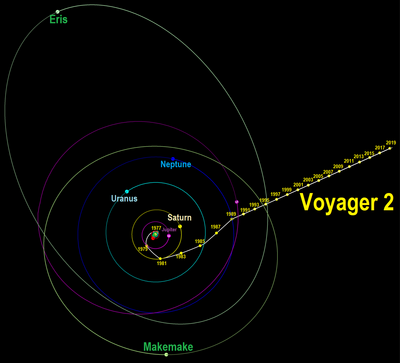 Path viewed from above the Solar System |
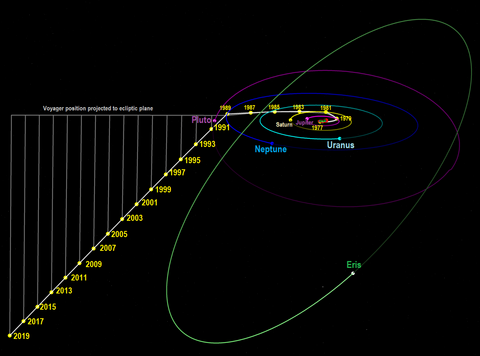 Path viewed from side, showing distance below ecliptic in gray |
| Timeline of travel | |||||||||||||||||||||||||||||||||||||||||||||||
|---|---|---|---|---|---|---|---|---|---|---|---|---|---|---|---|---|---|---|---|---|---|---|---|---|---|---|---|---|---|---|---|---|---|---|---|---|---|---|---|---|---|---|---|---|---|---|---|
| Date | Event | ||||||||||||||||||||||||||||||||||||||||||||||
| 1977-08-20 | Spacecraft launched at 14:29:00 UTC. | ||||||||||||||||||||||||||||||||||||||||||||||
| 1977-12-10 | Entered asteroid belt. | ||||||||||||||||||||||||||||||||||||||||||||||
| 1977-12-19 | Voyager 1 overtakes Voyager 2. (see diagram) | ||||||||||||||||||||||||||||||||||||||||||||||
| 1978-06 | Primary radio receiver fails. Remainder of mission flown using backup. | ||||||||||||||||||||||||||||||||||||||||||||||
| 1978-10-21 | Exited asteroid belt | ||||||||||||||||||||||||||||||||||||||||||||||
| 1979-04-25 | Start Jupiter observation phase
| ||||||||||||||||||||||||||||||||||||||||||||||
| 1981-06-05 | Start Saturn observation phase.
| ||||||||||||||||||||||||||||||||||||||||||||||
| 1985-11-04 | Start Uranus observation phase.
| ||||||||||||||||||||||||||||||||||||||||||||||
| 1987-08-20 | 10 years of continuous flight and operation at 14:29:00 UTC. | ||||||||||||||||||||||||||||||||||||||||||||||
| 1989-06-05 | Start Neptune observation phase.
| ||||||||||||||||||||||||||||||||||||||||||||||
| 1989-10-02 | Begin Voyager Interstellar Mission. | ||||||||||||||||||||||||||||||||||||||||||||||
| Interstellar phase[29][30][31] | |||||||||||||||||||||||||||||||||||||||||||||||
| 1997-08-20 | 20 years of continuous flight and operation at 14:29:00 UTC. | ||||||||||||||||||||||||||||||||||||||||||||||
| 1998-11-13 | Terminate scan platform and UV observations. | ||||||||||||||||||||||||||||||||||||||||||||||
| 2007-08-20 | 30 years of continuous flight and operation at 14:29:00 UTC. | ||||||||||||||||||||||||||||||||||||||||||||||
| 2007-09-06 | Terminate data tape recorder operations. | ||||||||||||||||||||||||||||||||||||||||||||||
| 2008-02-22 | Terminate planetary radio astronomy experiment operations. | ||||||||||||||||||||||||||||||||||||||||||||||
| 2011-11-07 | Switch to backup thrusters to conserve power[32] | ||||||||||||||||||||||||||||||||||||||||||||||
| 2017-08-20 | 40 years of continuous flight and operation at 14:29:00 UTC. | ||||||||||||||||||||||||||||||||||||||||||||||
| 2018-11-05 | Crossed the heliopause and entered interstellar space. | ||||||||||||||||||||||||||||||||||||||||||||||
| 2023-07-18 | Voyager 2 overtook Pioneer 10 as the second farthest spacecraft from the Sun. [33][34] | ||||||||||||||||||||||||||||||||||||||||||||||
Launch and trajectory
The Voyager 2 probe was launched on August 20, 1977, by NASA from Space Launch Complex 41 at Cape Canaveral, Florida, aboard a Titan IIIE/Centaur launch vehicle. Two weeks later, the twin Voyager 1 probe was launched on September 5, 1977. However, Voyager 1 reached both Jupiter and Saturn sooner, as Voyager 2 had been launched into a longer, more circular trajectory.
-
Voyager 2 launch on August 20, 1977, with a Titan IIIE/Centaur
-
Trajectory of Voyager 2 primary mission
-
Plot of Voyager 2's heliocentric velocity against its distance from the Sun, illustrating the use of gravity assists to accelerate the spacecraft by Jupiter, Saturn and Uranus. To observe Triton, Voyager 2 passed over Neptune's north pole, resulting in an acceleration out of the plane of the ecliptic, and, as a result, a reduced velocity relative to the Sun.[35]
Voyager 1's initial orbit had an aphelion of 8.9 AU (830 million mi; 1.33 billion km), just a little short of Saturn's orbit of 9.5 AU (880 million mi; 1.42 billion km). Voyager 2's initial orbit had an aphelion of 6.2 AU (580 million mi; 930 million km), well short of Saturn's orbit.[36]
In April 1978, a complication arose when no commands were transmitted to Voyager 2 for a period of time, causing the spacecraft to switch from its primary radio receiver to its backup receiver.[37] Sometime afterwards, the primary receiver failed altogether. The backup receiver was functional, but a failed capacitor in the receiver meant that it could only receive transmissions that were sent at a precise frequency, and this frequency would be affected by the Earth's rotation (due to the Doppler effect) and the onboard receiver's temperature, among other things.[37][38][39] For each subsequent transmission to Voyager 2, it was necessary for engineers to calculate the specific frequency for the signal so that it could be received by the spacecraft.
Encounter with Jupiter
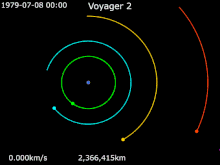
Voyager 2 · Jupiter · Io · Europa · Ganymede · Callisto
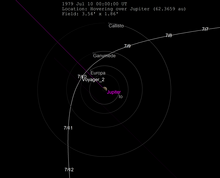
Voyager 2's closest approach to Jupiter occurred at 22:29 UT on July 9, 1979.[40] It came within 570,000 km (350,000 mi) of the planet's cloud tops.[41] Jupiter's Great Red Spot was revealed as a complex storm moving in a counterclockwise direction. Other smaller storms and eddies were found throughout the banded clouds.
Voyager 2 returned images of Jupiter, as well as its moons Amalthea, Io, Callisto, Ganymede, and Europa.[40] During a 10-hour "volcano watch", it confirmed Voyager 1's observations of active volcanism on the moon Io, and revealed how the moon's surface had changed in the four months since the previous visit.[40] Together, the Voyagers observed the eruption of nine volcanoes on Io, and there is evidence that other eruptions occurred between the two Voyager fly-bys.[42]
Jupiter's moon Europa displayed a large number of intersecting linear features in the low-resolution photos from Voyager 1. At first, scientists believed the features might be deep cracks, caused by crustal rifting or tectonic processes. Closer high-resolution photos from Voyager 2, however, were puzzling: the features lacked topographic relief, and one scientist said they "might have been painted on with a felt marker".[42] Europa is internally active due to tidal heating at a level about one-tenth that of Io. Europa is thought to have a thin crust (less than 30 km (19 mi) thick) of water ice, possibly floating on a 50 km (31 mi)-deep ocean.
Two new, small satellites, Adrastea and Metis, were found orbiting just outside the ring.[42] A third new satellite, Thebe, was discovered between the orbits of Amalthea and Io.[42]
-
The Great Red Spot photographed during the Voyager 2 flyby of Jupiter
-
A color mosaic of Europa
-
A color mosaic of Ganymede
-
Callisto photographed at a distance of 1 million kilometers
-
One faint ring of Jupiter photographed during the flyby
-
Atmospheric eruptive event on Jupiter
Encounter with Saturn
This section needs additional citations for verification. (August 2020) |
The closest approach to Saturn occurred at 03:24:05 UT on August 26, 1981.[43]
While passing behind Saturn (as viewed from Earth), Voyager 2 probed Saturn's upper atmosphere with its radio link to gather information on atmospheric temperature and density profiles. Voyager 2 found that at the uppermost pressure levels (seven kilopascals of pressure), Saturn's temperature was 70 K (−203.2 °C; −333.7 °F), while at the deepest levels (120 kilopascals), the temperature increased to 143 K (−130 °C; −202 °F). The north pole was found to be 10 K (−263.1 °C; −441.7 °F) cooler, although this may be seasonal (see also Saturn Oppositions).
After the fly-by of Saturn, the camera platform of Voyager 2 locked up briefly, putting plans to officially extend the mission to Uranus and Neptune in jeopardy. The mission's engineers were able to fix the problem (caused by an overuse that temporarily depleted its lubricant), and the Voyager 2 probe was given the go-ahead to explore the Uranian system.
-
Voyager 2 Saturn approach view
-
North, polar region of Saturn imaged in orange and UV filters
-
Color image of Enceladus showing terrain of widely varying ages
-
Cratered surface of Tethys at 594,000 km
-
Atmosphere of Titan imaged from 2.3 million km
-
Titan occultation of the Sun from 0.9 million km
-
Two-toned Iapetus, August 22, 1981
-
"Spoke" features observed in the rings of Saturn
Encounter with Uranus
The closest approach to Uranus occurred on January 24, 1986, when Voyager 2 came within 81,500 km (50,600 mi) of the planet's cloudtops.[44] Voyager 2 also discovered 11 previously unknown moons: Cordelia, Ophelia, Bianca, Cressida, Desdemona, Juliet, Portia, Rosalind, Belinda, Puck and Perdita.[A] The mission also studied the planet's unique atmosphere, caused by its axial tilt of 97.8°; and examined the Uranian ring system.[44] The length of a day on Uranus as measured by Voyager 2 is 17 hours, 14 minutes.[44] Uranus was shown to have a magnetic field that was misaligned with its rotational axis, unlike other planets that had been visited to that point,[45][48] and a helix-shaped magnetic tail stretching 10 million kilometers (6 million miles) away from the Sun.[45]
When Voyager 2 visited Uranus, much of its cloud features were hidden by a layer of haze; however, false-color and contrast-enhanced images show bands of concentric clouds around its south pole.[45] This area was also found to radiate large amounts of ultraviolet light, a phenomenon that is called "dayglow". The average atmospheric temperature is about 60 K (−351.7 °F; −213.2 °C). The illuminated and dark poles, and most of the planet, exhibit nearly the same temperatures at the cloud tops.
Detailed images from Voyager 2's flyby of the Uranian moon Miranda showed huge canyons made from geological faults.[45] One hypothesis suggests that Miranda might consist of a reaggregation of material following an earlier event when Miranda was shattered into pieces by a violent impact.[45]
Voyager 2 discovered two previously unknown Uranian rings.[45][46] Measurements showed that the Uranian rings are distinctly different from those at Jupiter and Saturn. The Uranian ring system might be relatively young, and it did not form at the same time that Uranus did. The particles that make up the rings might be the remnants of a moon that was broken up by either a high-velocity impact or torn up by tidal effects.
In March 2020, NASA astronomers reported the detection of a large atmospheric magnetic bubble, also known as a plasmoid, released into outer space from the planet Uranus, after reevaluating old data recorded during the flyby.[49][50]
Encounter with Neptune
Following a mid-course correction in 1987, Voyager 2's closest approach to Neptune occurred on August 25, 1989.[51][52][53] Through repeated computerized test simulations of trajectories through the Neptunian system conducted in advance, flight controllers determined the best way to route Voyager 2 through the Neptune-Triton system. Since the plane of the orbit of Triton is tilted significantly with respect to the plane of the ecliptic, through mid-course corrections, Voyager 2 was directed into a path about 4,950 km (3,080 mi) above the north pole of Neptune.[54][55] Five hours after Voyager 2 made its closest approach to Neptune, it performed a close fly-by of Triton, the larger of Neptune's two originally known moons, passing within about 40,000 km (25,000 mi).[54]
Voyager 2 discovered previously unknown Neptunian rings,[56] and confirmed six new moons: Despina, Galatea, Larissa, Proteus, Naiad and Thalassa.[57][B] While in the neighborhood of Neptune, Voyager 2 discovered the "Great Dark Spot", which has since disappeared, according to observations by the Hubble Space Telescope.[58] The Great Dark Spot was later hypothesized to be a region of clear gas, forming a window in the planet's high-altitude methane cloud deck.[59]
With the decision of the International Astronomical Union to reclassify Pluto as a dwarf planet in 2006,[60] the flyby of Neptune by Voyager 2 in 1989 retroactively became the point when every known planet in the Solar System had been visited at least once by a space probe.
-
Voyager 2 image of Neptune
-
Despina as imaged from Voyager 2
-
Cratered surface of Larissa
-
Dark surface of Proteus
-
Color mosaic of Voyager 2 Triton
-
Cirrus clouds imaged above gaseous Neptune
-
Rings of Neptune taken in occultation from 280,000 km
Interstellar mission
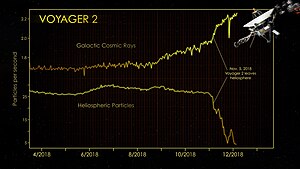
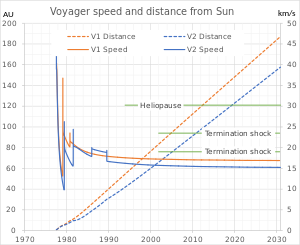

Once its planetary mission was over, Voyager 2 was described as working on an interstellar mission, which NASA is using to find out what the Solar System is like beyond the heliosphere. Voyager 2 is currently [when?] transmitting scientific data at about 160 bits per second. Information about continuing telemetry exchanges with Voyager 2 is available from Voyager Weekly Reports.[61]

In 1992, Voyager 2 observed the nova V1974 Cygni in the far-ultraviolet.[62]
In July 1994, an attempt was made to observe the impacts from fragments of the comet Comet Shoemaker–Levy 9 with Jupiter.[62] The craft's position meant it had a direct line of sight to the impacts and observations were made in the ultraviolet and radio spectrum.[62] Voyager 2 failed to detect anything, with calculations showing that the fireballs were just below the craft's limit of detection.[62]
On November 29, 2006, a telemetered command to Voyager 2 was incorrectly decoded by its on-board computer—in a random error—as a command to turn on the electrical heaters of the spacecraft's magnetometer. These heaters remained turned on until December 4, 2006, and during that time, there was a resulting high temperature above 130 °C (266 °F), significantly higher than the magnetometers were designed to endure, and a sensor rotated away from the correct orientation.[63] As of this date[when?] it had not been possible to fully diagnose and correct for the damage caused to Voyager 2's magnetometer, although efforts to do so were proceeding.[64][failed verification]
On August 30, 2007, Voyager 2 passed the termination shock and then entered into the heliosheath, approximately 1 billion mi (1.6 billion km) closer to the Sun than Voyager 1 did.[65] This is due to the interstellar magnetic field of deep space. The southern hemisphere of the Solar System's heliosphere is being pushed in.[66]
On April 22, 2010, Voyager 2 encountered scientific data format problems.[67] On May 17, 2010, JPL engineers revealed that a flipped bit in an on-board computer had caused the problem, and scheduled a bit reset for May 19.[68] On May 23, 2010, Voyager 2 resumed sending science data from deep space after engineers fixed the flipped bit.[69] Currently[as of?] research is being done regarding marking the area of memory with the flipped bit off limits or disallowing its use. The Low-Energy Charged Particle Instrument is currently operational, and data from this instrument concerning charged particles is being transmitted to Earth. This data permits measurements of the heliosheath and termination shock. There has also been a modification to the on-board flight software to delay turning off the AP Branch 2 backup heater for one year. It was scheduled to go off February 2, 2011 (DOY 033, 2011–033).
On July 25, 2012, Voyager 2 was traveling at 15.447 km/s (34,550 mph) relative to the Sun at about 99.13 AU (14.830 billion km; 9.215 billion mi) from the Sun,[8] at −55.29° declination and 19.888 h right ascension, and also at an ecliptic latitude of −34.0 degrees, placing it in the constellation Telescopium as observed from Earth.[70] This location places it deep in the scattered disc, and traveling outward at roughly 3.264 AU (303.4 million mi; 488.3 million km) per year. It is more than twice as far from the Sun as Pluto, and far beyond the perihelion of 90377 Sedna, but not yet beyond the outer limits of the orbit of the dwarf planet Eris.
On September 9, 2012, Voyager 2 was 99.077 AU (14.8217 billion km; 9.2098 billion mi) from the Earth and 99.504 AU (14.8856 billion km; 9.2495 billion mi) from the Sun; and traveling at 15.436 km/s (34,530 mph) (relative to the Sun) and traveling outward at about 3.256 AU (302.7 million mi; 487.1 million km) per year.[71] Sunlight takes 13.73 hours to get to Voyager 2. The brightness of the Sun from the spacecraft is magnitude −16.7.[71] Voyager 2 is heading in the direction of the constellation Telescopium.[dubious – discuss][71] To compare, Proxima Centauri, the closest star to the Sun, is about 4.2 light-years (or 2.65×105 AU) distant. Voyager 2's current relative velocity to the Sun is 15.436 km/s (55,570 km/h; 34,530 mph). This calculates as 3.254 AU (302.5 million mi; 486.8 million km) per year, about 10% slower than Voyager 1. At this velocity, 81,438 years would pass before Voyager 2 reaches the nearest star, Proxima Centauri, were the spacecraft traveling in the direction of that star. Voyager 2 will need about 19,390 years at its current velocity to travel a complete light year.
On November 7, 2012, Voyager 2 reached 100 AU (9.3 billion mi; 15 billion km) from the Sun, making it the third human-made object to reach that distance and the second that was still sending data to Earth at that distance. Voyager 1 was 122 AU (11.3 billion mi; 18.3 billion km) from the Sun, and Pioneer 10 is presumed to be at 107 AU (9.9 billion mi; 16.0 billion km). While Pioneer has ceased communications, both the Voyager spacecraft are performing well and are still communicating.
In 2013, Voyager 1 was escaping the Solar System at a speed of about 3.6 AU (330 million mi; 540 million km) per year, while Voyager 2 was escaping at 3.3 AU (310 million mi; 490 million km) per year.[72]
By February 25, 2019, Voyager 2 was at a distance of 120 AU (18.0 billion km; 11.2 billion mi) from the Sun.[8] There is a variation in distance from Earth caused by the Earth's revolution around the Sun relative to Voyager 2.[8]
It was originally thought that Voyager 2 would enter interstellar space in early 2016, with its plasma spectrometer providing the first direct measurements of the density and temperature of the interstellar plasma.[73] In December 2018, the Voyager project scientist, Edward C. Stone, announced that Voyager 2 reached interstellar space on November 5, 2018.[12][13]
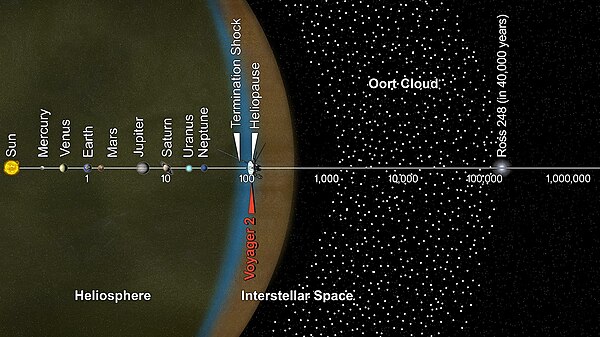
In October 2020, astronomers reported a significant unexpected increase in density in the space beyond the Solar System as detected by the Voyager 1 and Voyager 2 space probes. According to the researchers, this implies that "the density gradient is a large-scale feature of the VLISM (very local interstellar medium) in the general direction of the heliospheric nose".[74][75]
On July 18, 2023, Voyager 2 overtook Pioneer 10 as the second farthest spacecraft from the Sun. [76] [77]
Reductions in capabilities
As the power from the RTG slowly reduces, various items of equipment have been turned off on the spacecraft.[78] The first science equipment turned off on Voyager 2 was the PPS in 1991, which saved 1.2 watts.[78]
| Year | End of specific capabilities as a result of the available electrical power limitations[79] |
|---|---|
| 1998 | Termination of scan platform and UVS observations |
| 2007 | Termination of Digital Tape Recorder (DTR) operations (It was no longer needed due to a failure on the High Waveform Receiver on the Plasma Wave Subsystem (PWS) on June 30, 2002.)[80] |
| 2008 | Power off Planetary Radio Astronomy Experiment (PRA) |
| 2016 approx | Termination of gyroscopic operations |
| 2019 | CRS heater turned off[81] |
| 2020 approx | Initiate instrument power sharing |
| 2021 | Turn off Low Energy Charged Particle instrument[82] |
| 2023 | Software update reroutes power from the voltage regulator to keep the science instruments operating[83] |
| 2026 or slightly afterwards | Can no longer power any instrument |
Future of the probe
The probe is expected to keep transmitting weak radio messages until at least the mid-2020s, more than 48 years after it was launched.[84]
Distant future
Voyager 2 is not headed toward any particular star, although in roughly 42,000 years, it will have a close approach with the star Ross 248 at a distance of a few light-years.[85][86] If undisturbed for 296,000 years, Voyager 2 should pass by the star Sirius at a distance of 4.3 light-years.[87]
Golden record
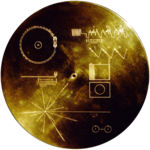
Both Voyager space probes carry a gold-plated audio-visual disc in the event that either spacecraft is ever found by intelligent life-forms from other planetary systems.[88] The discs carry photos of the Earth and its lifeforms, a range of scientific information, spoken greetings from the people (e.g. the Secretary-General of the United Nations and the President of the United States, and the children of the Planet Earth) and a medley, "Sounds of Earth", that includes the sounds of whales, a baby crying, waves breaking on a shore, and a collection of music, including works by Wolfgang Amadeus Mozart, Blind Willie Johnson, Chuck Berry's 1958 recording of "Johnny B. Goode", Valya Balkanska and other Eastern and Western classics and ethnic performers.[89] (see also Music in space)
See also
- Family Portrait
- The Farthest, a 2017 documentary on the Voyager program.
- List of artificial objects leaving the Solar System
- List of missions to the outer planets
- New Horizons
- Pioneer 10
- Pioneer 11
- Timeline of artificial satellites and space probes
- Voyager 1
Notes
- ^ Some sources cite the discovery of only 10 Uranian moons by Voyager 2,[45][46] but Perdita was discovered in Voyager 2 images more than a decade after they were taken.[47]
- ^ One of these moons, Larissa, was first reported in 1981 from ground telescope observations, but not confirmed until the Voyager 2 approach.[57]
References
- ^ "Voyager: Mission Information". NASA. 1989. Archived from the original on February 20, 2017. Retrieved January 2, 2011.
- ^ "Voyager 2". US National Space Science Data Center. Retrieved August 25, 2013.
- ^ "Voyager 2". N2YO. Retrieved August 25, 2013.
- ^ "Voyager 2". NASA's Solar System Exploration website. Retrieved December 4, 2022.
- ^ a b c Butrica, Andrew. From Engineering Science to Big Science. p. 267. Retrieved September 4, 2015.
Despite the name change, Voyager remained in many ways the Grand Tour concept, though certainly not the Grand Tour (TOPS) spacecraft. Voyager 2 was launched on August 20, 1977, followed by Voyager 1 on September 5, 1977. The decision to reverse the order of launch had to do with keeping open the possibility of carrying out the Grand Tour mission to Uranus, Neptune, and beyond. Voyager 2, if boosted by the maximum performance from the Titan-Centaur, could just barely catch the old Grand Tour trajectory and encounter Uranus. Two weeks later, Voyager 1 would leave on an easier and much faster trajectory, visiting Jupiter and Saturn only. Voyager 1 would arrive at Jupiter four months ahead of Voyager 2, then arrive at Saturn nine months earlier. Hence, the second spacecraft launched was Voyager 1, not Voyager 2. The two Voyagers would arrive at Saturn nine months apart, so that if Voyager 1 failed to achieve its Saturn objectives, for whatever reason, Voyager 2 still could be retargeted to achieve them, though at the expense of any subsequent Uranus or Neptune encounter.
- ^ "Voyager – Mission Status". Jet Propulsion Laboratory. National Aeronautics and Space Administration. Retrieved July 9, 2023.
- ^ "Convert light years to astronomical unit – Conversion of Measurement Units". www.convertunits.com.
- ^ a b c d Staff (September 9, 2012). "Where are the Voyagers?". NASA. Retrieved September 9, 2012.
- ^ "Voyager – Mission Status". voyager.jpl.nasa.gov.
- ^ University of Iowa (November 4, 2019). "Voyager 2 reaches interstellar space – Iowa-led instrument detects plasma density jump, confirming spacecraft has entered the realm of the stars". EurekAlert!. Retrieved November 4, 2019.
- ^ Chang, Kenneth (November 4, 2019). "Voyager 2's Discoveries From Interstellar Space – In its journey beyond the boundary of the solar wind's bubble, the probe observed some notable differences from its twin, Voyager 1". The New York Times. Retrieved November 5, 2019.
- ^ a b Gill, Victoria (December 10, 2018). "Nasa's Voyager 2 probe 'leaves the Solar System'". BBC News. Retrieved December 10, 2018.
- ^ a b c d Brown, Dwayne; Fox, Karen; Cofield, Calia; Potter, Sean (December 10, 2018). "Release 18–115 – NASA's Voyager 2 Probe Enters Interstellar Space". NASA. Retrieved December 10, 2018.
- ^ "At last, Voyager 1 slips into interstellar space – Atom & Cosmos". Science News. September 12, 2013. Archived from the original on September 15, 2013. Retrieved September 17, 2013.
- ^ NASA Voyager – The Interstellar Mission Mission Overview Archived May 2, 2011, at the Wayback Machine
- ^ Dockrill, Peter (November 5, 2020). "NASA finally makes contact with Voyager 2 after longest radio silence in 30 years". Live Science. Retrieved November 5, 2020.
- ^ Shannon Stirone (February 12, 2021). "Earth to Voyager 2: After a Year in the Darkness, We Can Talk to You Again – NASA's sole means of sending commands to the distant space probe, launched 44 years ago, is being restored on Friday". The New York Times. Archived from the original on December 28, 2021. Retrieved February 14, 2021.
- ^ Planetary Voyage NASA Jet Propulsion Laboratory – California Institute of Technology. March 23, 2004. Retrieved April 8, 2007.
- ^ a b "Voyager 2: Host Information". NASA. 1989. Archived from the original on February 20, 2017. Retrieved January 2, 2011.
- ^ "NASA News Press Kit 77–136". JPL/NASA. Retrieved December 15, 2014.
- ^ "Voyager 2 Craft Details". NASA-NSSDC-Spacecraft-Details. NASA. Retrieved March 9, 2011.
- ^ Furlong, Richard R.; Wahlquist, Earl J. (1999). "U.S. space missions using radioisotope power systems" (PDF). Nuclear News. 42 (4): 26–34. Retrieved January 2, 2011.
- ^ "NASA's Voyager Will Do More Science With New Power Strategy". Jet-Propulsion-Laboratory. Retrieved April 28, 2023.
- ^ "MR-103". Astronautix.com. Archived from the original on December 28, 2016. Retrieved December 11, 2018.
- ^ "Voyager Backgrounder" (PDF). Nasa.gov. Nasa. October 1980. Retrieved December 11, 2018.
- ^ Koerner, Brendan (November 6, 2003). "What Fuel Does Voyager 1 Use?". Slate.com. Retrieved December 11, 2018.
- ^ NASA/JPL (August 26, 2003). "Voyager 1 Narrow Angle Camera Description". NASA / PDS. Retrieved January 17, 2011.
- ^ NASA/JPL (August 26, 2003). "Voyager 1 Wide Angle Camera Description". NASA / PDS. Retrieved January 17, 2011.
- ^ "Voyager 2 Full Mission Timeline" Archived July 23, 2011, at the Wayback Machine Muller, Daniel, 2010
- ^ "Voyager Mission Description" NASA, February 19, 1997
- ^ "JPL Mission Information" Archived February 20, 2017, at the Wayback Machine NASA, JPL, PDS.
- ^ Sullivant, Rosemary (November 5, 2011). "Voyager 2 to Switch to Backup Thruster Set". JPL. 2011-341. Archived from the original on February 26, 2021. Retrieved October 5, 2018.
- ^ "Distance between the Sun and Voyager 2".
{{cite web}}: CS1 maint: url-status (link) - ^ "Distance between the Sun and Pioneer 10".
{{cite web}}: CS1 maint: url-status (link) - ^ "Basics of space flight: Interplanetary Trajectories".
- ^ HORIZONS, JPL Solar System Dynamics (Ephemeris Type ELEMENTS; Target Body: Voyager n (spacecraft); Center: Sun (body center); Time Span: launch + 1 month to Jupiter encounter – 1 month)
- ^ a b Henbest, Nigel (January 31, 1985). "All set to encounter Uranus". New Scientist. p. 24.
- ^ Littmann, Mark (2004). Planets Beyond: Discovering the Outer Solar System. Courier Corporation. p. 106. ISBN 978-0-486-43602-9.
- ^ Davies, John (January 23, 1986). "Voyage to the tilted planet". New Scientist. p. 42.
- ^ a b c National Aeronautics and Space Administration "Voyager 2" NASA Science: Solar System Exploration. Updated January 26, 26, 2018. Accessed December 12, 2018.
- ^ "History". www.jpl.nasa.gov. Archived from the original on April 16, 2022. Retrieved October 5, 2018.
- ^ a b c d "Voyager Fact Sheet". JPL. Retrieved December 11, 2018.
- ^ "NASA – NSSDCA – Master Catalog – Event Query". nssdc.gsfc.nasa.gov.
- ^ a b c "Uranus Approach" NASA Jet Propulsion Laboratory, California Institute of Technology. Accessed December 11, 2018.
- ^ a b c d e f g Elizabeth Landau (2016) "Voyager Mission Celebrates 30 Years Since Uranus" National Aeronautics and Space Administration, January 22, 2016. Accessed December 11, 2018
- ^ a b Voyager 2 Mission Team (2012) "1986: Voyager at Uranus" NASA Science: Solar System Exploration, December 14, 2012. Accessed December 11, 2018.
- ^ Karkoschka, E. (2001). "Voyager's Eleventh Discovery of a Satellite of Uranus and Photometry and the First Size Measurements of Nine Satellites". Icarus. 151 (1): 69–77. Bibcode:2001Icar..151...69K. doi:10.1006/icar.2001.6597.
- ^ Russell, C. T. (1993). "Planetary magnetospheres". Reports on Progress in Physics. 56 (6): 687–732. Bibcode:1993RPPh...56..687R. doi:10.1088/0034-4885/56/6/001. S2CID 250897924.
- ^ Hatfield, Miles (March 25, 2020). "Revisiting Decades-Old Voyager 2 Data, Scientists Find One More Secret – Eight and a half years into its grand tour of the solar system, NASA's Voyager 2 spacecraft was ready for another encounter. It was Jan. 24, 1986, and soon it would meet the mysterious seventh planet, icy-cold Uranus". NASA. Retrieved March 27, 2020.
- ^ Andrews, Robin George (March 27, 2020). "Uranus Ejected a Giant Plasma Bubble During Voyager 2's Visit – The planet is shedding its atmosphere into the void, a signal that was recorded but overlooked in 1986 when the robotic spacecraft flew past". The New York Times. Retrieved March 27, 2020.
- ^ "Voyager Steered Toward Neptune". Ukiah Daily Journal. March 15, 1987. Retrieved December 6, 2017.
- ^ "Fact Sheet". JPL. Retrieved March 3, 2016.
- ^ Nardo 2002, p. 15
- ^ a b National Aeronautics and Space Administration "Neptune Approach" NASA Jet Propulsion Laboratory: California Institute of Technology. Accessed December 12, 2018.
- ^ "Neptune". Jet Propulsion Laboratory. Retrieved March 3, 2016.
- ^ National Aeronautics and Space Administration "Neptune Moons" NASA Science: Solar System Exploration. Updated December 6, 2017. Accessed December 12, 2018.
- ^ a b Elizabeth Howell (2016) "Neptune's Moons: 14 Discovered So Far" Space.com, June 30, 2016. Accessed December 12, 2018.
- ^ Phil Plait (2016) "Neptune Just Got a Little Dark" Slate, June 24, 2016. Accessed December 12, 2018.
- ^ National Aeronautics and Space Administration (1998) "Hubble Finds New Dark Spot on Neptune" NASA Jet Propulsion Laboratory: California Institute of Technology, August 2, 1998. Accessed December 12, 2018.
- ^ "Pluto loses status as a planet" BBC News, August 24, 2006. Accessed December 12, 2018.
- ^ "Voyager Weekly Reports". Voyager.jpl.nasa.gov. September 6, 2013. Retrieved September 14, 2013.
- ^ a b c d Ulivi, Paolo; Harland, David M (2007). Robotic Exploration of the Solar System Part I: The Golden Age 1957–1982. Springer. p. 449. ISBN 9780387493268.
- ^ Shuai, Ping (2021). Understanding Pulsars and Space Navigations. Springer Singapore. p. 189. ISBN 9789811610677.
- ^ "Notes on Voyager 2 Quick Look Data: Data after November 29, 2006".
- ^ "NASA – Voyager 2 Proves Solar System Is Squashed". www.nasa.gov.
- ^ Voyager 2 finds solar system's shape is 'dented' # 2007-12-10, Week Ending December 14, 2007. Retrieved December 12, 2007.
- ^ John Antczak (May 6, 2010). "NASA working on Voyager 2 data problem". Associated Press.
- ^ "Engineers Diagnosing Voyager 2 Data System". Jet Propulsion Laboratory. Archived from the original on June 12, 2010. Retrieved May 17, 2010.
- ^ "NASA Fixes Bug On Voyager 2". Retrieved May 25, 2010.
- ^ Peat, Chris. "Spacecraft escaping the Solar System". Heavens Above. Retrieved May 23, 2010.
- ^ a b c Peat, Chris (September 9, 2012). "Spacecraft escaping the Solar System". Heavens-Above. Retrieved September 9, 2012.
- ^ "Voyager – Fast Facts". voyager.jpl.nasa.gov.
- ^ "At last, Voyager 1 slips into interstellar space – Atom & Cosmos". Science News. September 12, 2013. Archived from the original on September 15, 2013. Retrieved September 17, 2013.
- ^ Starr, Michelle (October 19, 2020). "Voyager Spacecraft Detect an Increase in The Density of Space Outside The Solar System". ScienceAlert. Retrieved October 19, 2020.
- ^ Kurth, W.S.; Gurnett, D.A. (August 25, 2020). "Observations of a Radial Density Gradient in the Very Local Interstellar Medium by Voyager 2". The Astrophysical Journal Letters. 900 (1): L1. Bibcode:2020ApJ...900L...1K. doi:10.3847/2041-8213/abae58. S2CID 225312823. Retrieved October 19, 2020.
{{cite journal}}: CS1 maint: unflagged free DOI (link) - ^ "Distance between the Sun and Voyager 2".
- ^ "Distance between the Sun and Pioneer 10".
- ^ a b "Voyager – Operations Plan to the End Mission". voyager.jpl.nasa.gov. Retrieved September 20, 2019.
- ^ "Voyager – The Spacecraft". voyager.jpl.nasa.gov.
- ^ "Voyager – Interstellar Science". NASA Jet Propulsion Laboratory. December 1, 2009. Retrieved December 2, 2009.
- ^ "A New Plan for Keeping NASA's Oldest Explorers Going". NASA/JPL. Retrieved January 2, 2020.
- ^ Stirone, Shannon (February 12, 2021). "Earth to Voyager 2: After a Year in the Darkness, We Can Talk to You Again". The New York Times. Retrieved February 12, 2021.
- ^ "NASA's Voyager Will Do More Science With New Power Strategy". NASA/JPL. Retrieved May 1, 2023.
- ^ "Voyager – Spacecraft – Spacecraft Lifetime". NASA Jet Propulsion Laboratory. March 15, 2008. Retrieved May 25, 2008.
- ^ "Voyager – Mission – Interstellar Mission". NASA. June 22, 2007. Retrieved August 14, 2013.
- ^ Bailer-Jones, Coryn A. L.; Farnocchia, Davide (April 3, 2019). "Future stellar flybys of the Voyager and Pioneer spacecraft". Research Notes of the AAS. 3 (4): 59. arXiv:1912.03503. Bibcode:2019RNAAS...3...59B. doi:10.3847/2515-5172/ab158e. S2CID 134524048.
{{cite journal}}: CS1 maint: unflagged free DOI (link) - ^ Baldwin, Paul (December 4, 2017). "NASA's Voyager 2 heads for star Sirius... by time it arrives humans will have died out". Express.co.uk. Retrieved September 1, 2022.
- ^ Ferris, Timothy (May 2012). "Timothy Ferris on Voyagers' Never-Ending Journey". Smithsonian Magazine. Archived from the original on November 4, 2013. Retrieved June 15, 2012.
- ^ "Voyager Golden record". JPL. Retrieved August 18, 2013.
Further reading
- "Saturn Science Results". Voyager Science Results at Saturn. Retrieved February 8, 2005.
- "Uranus Science Results". Voyager Science Results at Uranus. Retrieved February 8, 2005.
- Nardo, Don (2002). Neptune. Thomson Gale. ISBN 0-7377-1001-2
- JPL Voyager Telecom Manual
External links
- Voyager program
- 1977 in spaceflight
- 1977 in the United States
- 1977 robots
- August 1977 events in the United States
- Individual space vehicles
- Missions to Jupiter
- Missions to Neptune
- Missions to Saturn
- Missions to Uranus
- NASA space probes
- Nuclear-powered robots
- Radio frequency propagation
- Spacecraft escaping the Solar System
- Spacecraft launched by Titan rockets
- Spacecraft launched in 1977

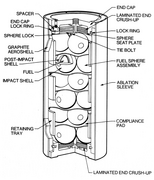
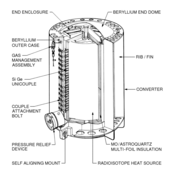
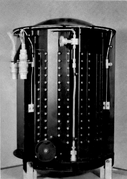
















![Plot of Voyager 2's heliocentric velocity against its distance from the Sun, illustrating the use of gravity assists to accelerate the spacecraft by Jupiter, Saturn and Uranus. To observe Triton, Voyager 2 passed over Neptune's north pole, resulting in an acceleration out of the plane of the ecliptic, and, as a result, a reduced velocity relative to the Sun.[35]](http://upload.wikimedia.org/wikipedia/commons/thumb/2/2c/Voyager_2_velocity_vs_distance_from_sun.svg/200px-Voyager_2_velocity_vs_distance_from_sun.svg.png)
